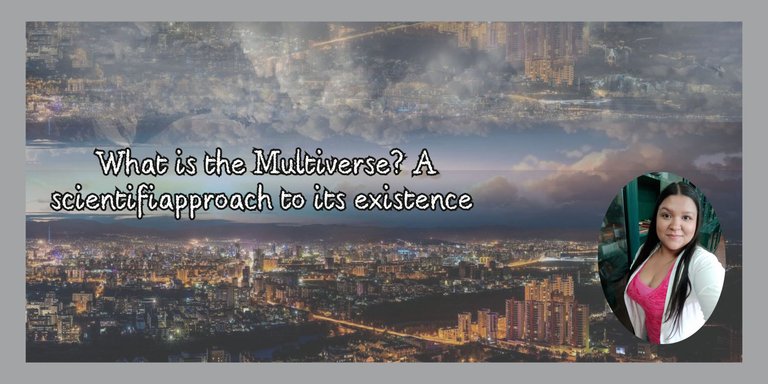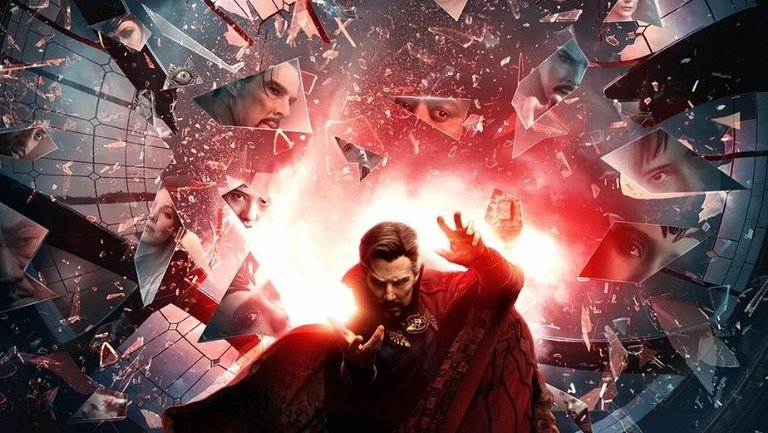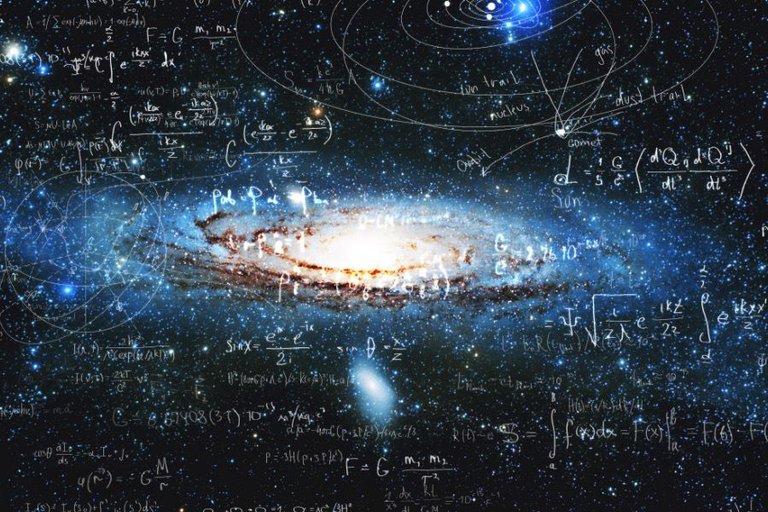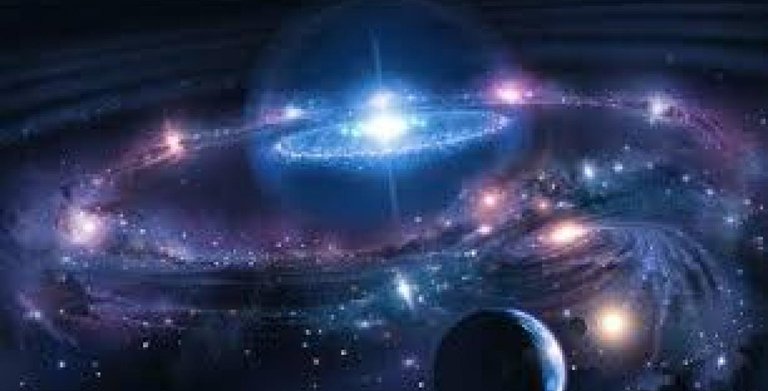¡Hola querida comunidad científica de #Hive, reciban todos un cordial saludo!🖐
Hello dear #Hive scientific community, receive warm greetings from all of you!🖐
Hoy quiero hacer un pequeño ensayo no tan argumentativo, sino más bien de opinión. Resulta que días anteriores me encontraba haciendo algunas lecturas sobre los agujeros negros y la teoría del Big Bang, en ese paseo documental pude encontrar algunas opiniones acerca del Multiverso, inmediatamente vinieron a mi cabeza innumerables escenas de películas donde se hace mención de este hecho.
Today I want to make a small essay not so much argumentative, but rather of opinion. It turns out that days before I was doing some reading about black holes and the Big Bang theory, in that documentary walk I could find some opinions about the Multiverse, immediately came to my head countless movie scenes where mention of this fact is made.

Main image taken from the following link // General design made in Canva
Sabemos que existe un gran número de películas que hablan acerca de Multiversos; las más populares son la serie Avengers, la cuál son películas de ciencia ficción donde se logra evidenciar algunos conceptos científicos específicamente de la teoría cuántica. Sin embargo, hay una película llamada Doctor Strange en el Multiverso de la Locura y resulta ser un ejemplo de cómo las producciones de ciencia ficción se encuentran llenas de interacciones creativas con otras realidades que son alternativas.
Sin embargo, estás posibles ideas acerca del Multiverso son realmente muy antiguas, por ejemplo, en 1848 un poeta llamado Edgar Allan escribió una prosa en el que se imaginaba “una sucesión limitada de universos’ y con ello hacía mención a la existencia de muchos universos“. No obstante, está opción no logró ser considerada hasta que teorías científicas intentaron explicar las propiedades del universo e hicieron mención acerca de la presencia de otros universos, dónde los eventos que ocurren están fuera de nuestra percepción.
We know that there are a great number of movies that talk about Multiverses; the most popular ones are the Avengers series, which are science fiction movies where some scientific concepts specifically from the quantum theory are evidenced. However, there is a movie called Doctor Strange in the Multiverse of Madness and it turns out to be an example of how science fiction productions are full of creative interactions with other realities that are alternative.
However, these possible ideas about the Multiverse are actually very old, for example, in 1848 a poet named Edgar Allan wrote a prose in which he imagined “a limited succession of universes' and thereby made mention of the existence of many universes”. However, this option could not be considered until scientific theories tried to explain the properties of the universe and made mention of the presence of other universes, where the events that occur are outside our perception.
Pero, el físico Andrei Linde hace una acotación muy importante “Nuestra comprensión de la realidad no es para nada completa” y culmina su frase con “existe independientemente de nosotros”, y con esta opinión dejó saber que en realidad no sabemos nada acerca de la realidad, es decir, que si de verdad esos universos existen escapan de nuestra comprensión y son inalcanzables e indetectables por cualquier medición directa, partiendo de ello aún existen dudas de que sea algo verdaderamente científico.
Ahora bien, ¿Qué es un Multiverso? Es un término científico que se le atribuye a la existencia de algo más allá del universo que podemos observar, es decir, la presencia de varios universos. Estos Multiversos han sido mencionados por varias teorías científicas que describen diferentes escenarios posibles, desde regiones del espacio, hasta universos en. Burbujas separadas; y todas estas teorías convergen en una misma idea: “el espacio y tiempo que logramos observar no es la única realidad existente”.
But, the physicist Andrei Linde makes a very important remark “Our understanding of reality is not at all complete” and ends his sentence with “it exists independently of us”, and with this opinion he let us know that in reality we do not know anything about reality, that is to say, that if these universes really exist they escape our understanding and are unreachable and undetectable by any direct measurement, based on this there are still doubts that it is something truly scientific.
Now, what is a Multiverse? It is a scientific term attributed to the existence of something beyond the universe that we can observe, that is, the presence of several universes. These Multiverses have been mentioned by several scientific theories that describe different possible scenarios, from regions of space, to universes in. Separate bubbles; and all these theories converge in the same idea: “the space and time we are able to observe is not the only existing reality”.
Innumerables interrogantes emergen en la cabeza de científicos de alto prestigio, como por ejemplo, Siegfried quien se pregunta, ¿Por qué las constantes fundamentales de la naturaleza son lo que son? ¿Por qué hay suficiente tiempo en nuestro universo para crear estrellas y planetas? ¿Por qué las estrellas brillan de la manera en que lo hacen, con la cantidad justa de energía? Son preguntas que no tienen respuesta y para ellas Siegfried tiene dos alternativas, la primera de ellas es que se necesitan nuevas teorías y la segunda es que posiblemente “seamos solo uno de los muchos universos que son diferentes y a nosotros nos tocó vivir en el más cómodo.
No obstante, dentro de las teorías más conocidas sobre el Multiverso, se encuentra la llamada “Cosmología Inflacionaria” que señala que después de la explosión del Big Bang el universo se expandió de manera rápida y exponencial. Dicha teoría explica algunas de las propiedades que se pueden observar en el universo, tal como la estructura y distribución de las galaxias.
A pesar de que a simple vista esta teoría puede parecer algo imaginativa y con muchos vacíos, a través de ella se puede explicar muchas características interesantes de nuestro mundo. Una de las grandes predicciones de dicha teoría, es que la inflación puede ocurrir una y otra vez, incluso de manera infinita, creando una constelación de universos - burbuja. Pero, esas burbujas no necesariamente tienen las mismas propiedades que la nuestra, pueden ser espacios donde las leyes de la física que conocemos se comportan de manera diferente.
Countless questions emerge in the heads of prestigious scientists, such as Siegfried who asks, why are the fundamental constants of nature what they are? Why is there enough time in our universe to create stars and planets? Why do stars shine the way they do, with just the right amount of energy? These are questions that have no answers and Siegfried has two alternatives for them, the first being that new theories are needed and the second that “we are possibly just one of many universes that are different and we just happen to live in the most comfortable one.
However, among the best known theories about the Multiverse is the so-called “Inflationary Cosmology” which states that after the explosion of the Big Bang the universe expanded rapidly and exponentially. This theory explains some of the properties that can be observed in the universe, such as the structure and distribution of galaxies.
Although at first glance this theory may seem somewhat imaginative and with many gaps, it can explain many interesting features of our world. One of the great predictions of this theory is that inflation can occur again and again, even infinitely, creating a constellation of bubble universes. But these bubbles do not necessarily have the same properties as ours, they may be spaces where the laws of physics we know behave differently.
Otra teoría que resulta ser lógica, es la interpretación de muchos mundos mediante la mecánica cuántica, ya que está logra explicar matemáticamente el comportamiento de la materia. En 1957, el científico Hugh Everett establece que “la interpretación de muchos mundos predice la presencia de líneas de tiempo ramificadas o realidades alternativas”.
En conclusión, este científico lo que establece es que existe un gran número de Tierras paralelas y cuando realizas algún experimento y obtienes las probabilidades, se puede evidenciar que se vive en la Tierra donde ese fue el resultado del experimento, o mejor dicho que en otra Tierra el resultado experimental sería otro.
Finalmente, existen múltiples teorías acerca del Multiverso, pero la realidad es que no podemos viajar en él, los científicos no lo creen posible por lo menos en este momento. Sin embargo, el futuro es incierto y el día de mañana el universo puede comportarse como él quiera y a pesar de que aún no existan explicaciones sólidas no quiere decir que no exista o que no se pueda, simplemente aún no sabemos cómo hacerlo, tal vez algún día podamos comprobar, responder muchas interrogantes o incluso viajar a través del Multiverso.
Another theory that is logical is the many-worlds interpretation of quantum mechanics, which mathematically explains the behavior of matter. In 1957, the scientist Hugh Everett states that “the many-worlds interpretation predicts the presence of branching timelines or alternative realities”.
In conclusion, what this scientist establishes is that there are a great number of parallel Earths and when you perform an experiment and obtain the probabilities, it can be evidenced that one lives on the Earth where that was the result of the experiment, or rather that on another Earth the experimental result would be another.
Finally, there are multiple theories about the Multiverse, but the reality is that we cannot travel in it, scientists do not believe it possible at least at this moment. However, the future is uncertain and tomorrow the universe may behave as it wants and although there are still no solid explanations does not mean that it does not exist or that it is not possible, we just do not know how to do it, maybe someday we can prove, answer many questions or even travel through the Multiverse.
Ya para despedirme, agradezco a quienes se tomarnos unos minutos de su tiempo para leer mi publicación y me encantaría poder leer en los comentarios sus opiniones e impresiones sobre el tema.
In closing, I would like to thank those of you who took a few minutes of your time to read my publication and I would love to read in the comments your opinions and impressions on the subject.
Referencias
Drake, N. (2022). ¿Existe el multiverso? Lo que dice la ciencia. [Documento en línea] Disponible en:
Equipo de Expertos de Ciencia y Tecnología de la Universidad Internacional de Valencia. (2022). ¿En qué consiste la teoría del multiverso?. [Documento en línea] Disponible en:
References
Drake, N. (2022). Does the multiverse exist? What science says. [Online document] Available at:.
Science and Technology Expert Team of the International University of Valencia (2022): What is the multiverse theory? [Online document] Available at:.
Translator Deepl


Posted Using InLeo Alpha



~~~ embed:1831486117058900484?t=Wbr7ndjNmvqScLnuttZecg&s=19 twitter metadata:SUxvdmVQaHlzaWNhfHxodHRwczovL3R3aXR0ZXIuY29tL0lMb3ZlUGh5c2ljYS9zdGF0dXMvMTgzMTQ4NjExNzA1ODkwMDQ4NHw= ~~~
Congratulations @hannymarchan! You received a personal badge!
You can view your badges on your board and compare yourself to others in the Ranking
Check out our last posts:
Thanks for your contribution to the STEMsocial community. Feel free to join us on discord to get to know the rest of us!
Please consider delegating to the @stemsocial account (85% of the curation rewards are returned).
You may also include @stemsocial as a beneficiary of the rewards of this post to get a stronger support.